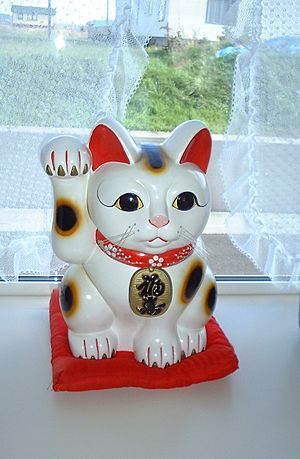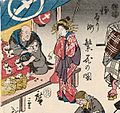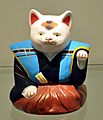Maneki Neko facts for kids
The Maneki Neko (pronounced mah-NEH-kee NEH-koh) is a famous Japanese statue. Its name means "beckoning cat," and it's known as a lucky charm. You can often spot these small cat statues in shops and restaurants, not just in Japan but all around the world! People believe they bring good luck, customers, and money.
Most Maneki Neko statues look like a Calico cat (a cat with patches of different colors), often a Japanese Bobtail. But today, you can find them in many colors like white, red, black, pink, blue, and gold. The cat usually has one paw raised, like it's waving or inviting you in. Many statues also have a gold coin, called a koban, around their neck. The town of Tokoname in Aichi Prefecture is famous for making many of these charming cat figures.
Contents
What Do the Colors Mean?
The color of a Maneki Neko can tell you what kind of luck it's supposed to bring:
- Red or Black: These colors are often chosen to help you stay healthy and avoid getting sick.
- Pink: A pink Maneki Neko is thought to bring good luck in love and relationships.
- Gold: If you see a gold cat, it's usually meant to bring good fortune with money and wealth.
- Calico: This is the traditional color for Maneki Neko, and it's generally believed to bring overall good luck.
What Does the Paw Gesture Mean?
Maneki Neko statues can have either their right paw or left paw raised, and sometimes even both! Each paw has a different meaning:
- Right Paw Raised: This gesture is generally believed to bring good luck and wealth to a business or home.
- Left Paw Raised: If the left paw is up, it's usually meant to attract more customers and visitors.
The History of the Lucky Cat
The Maneki Neko has a long history in Japan. It was once a special symbol for the silk industry, helping to bring good fortune to silk businesses. Today, it's mostly seen as a symbol for general business success and good luck.
There are different stories about where the Maneki Neko first came from. Some people believe it started at the Imado temples, while others say it began at the Gotoku temples. In the past, most Maneki Neko were made from wood. But now, many are made from plastic, making them more common and affordable.
Related Pages
Images for kids
-
"Joruri-machi Hanka no zu" by Utagawa Hiroshige, 1852
-
A wooden mold for a maneki-neko and Okiagari-Koboshi Daruma doll from the Edo Period, 18th century. Brooklyn Museum.
-
Fushimi clay doll by Tanka
See also
 In Spanish: Maneki-neko para niños
In Spanish: Maneki-neko para niños








